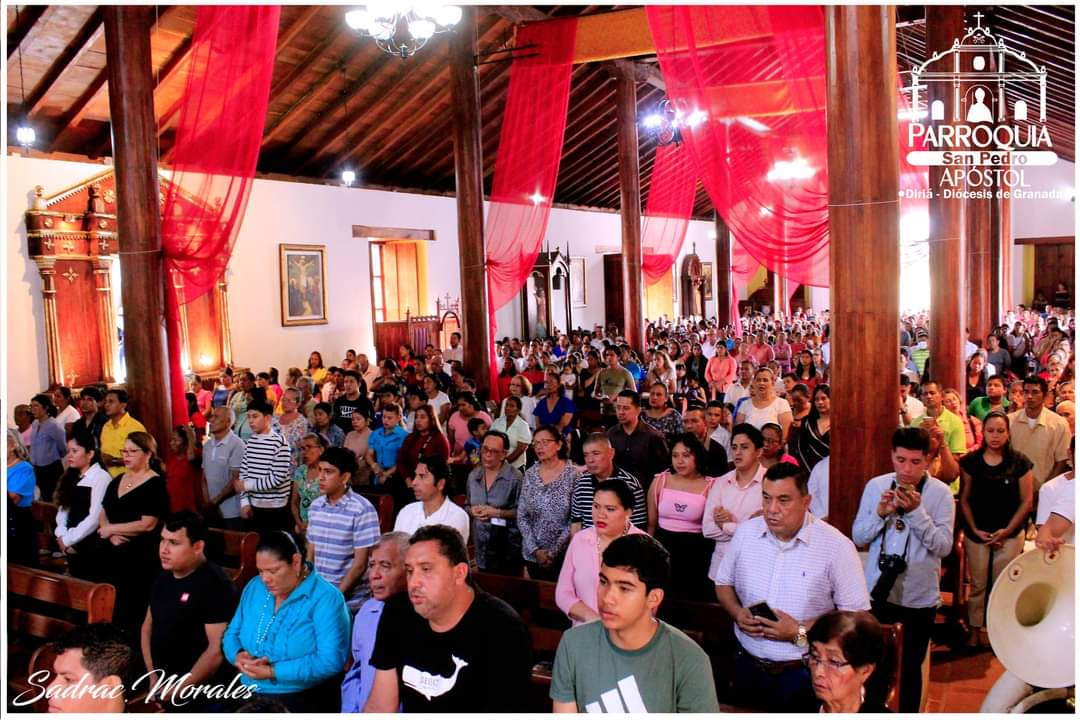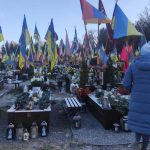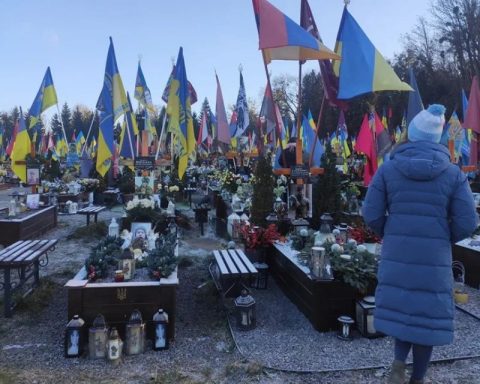The small town of San Juan de Oriente, in the municipality of Masaya, celebrated the patron saint festivities in honor of Saint John the Baptist these days. Although the image of the patron saint remained in the temple, the devotees came every afternoon to pray the Rosary and celebrate the Eucharist, making it clear that repression has not diminished the faith and devotion of the Catholic people.
On the solemnity of June 24, the temple was packed with faithful who came to participate in the mass presided by Cardinal Leopoldo Brenes along with several priests. After the religious ceremony, the image went out to the central door of the temple, where with the ringing of bells, rockets and the rhythm of the philharmonic, the people danced to their patron saint.
The tradition every year was that the image traveled through the neighborhoods of the town and in the houses where the image stopped, families used to give away corn chicha, donuts and the traditional casserole dough, but this year, the devotees distributed the food in the surroundings of the temple, as a sign of sharing their blessings with their neighbors, defying the prohibitions.
They do not bend the dance of the “chinegros”
One of the traditions of this town of clay artisans is the dance of the “chinegros”, where the devotees, to the rhythm of the philharmonic, play at lacerating their bodies with a kind of sword that they build from the virile member of the bull and that they leave to dry in the sun for more than two months, so that it becomes rigid.
“Last year, the police tried to stop us from performing the Chinegros dance, but they couldn’t stop this tradition that is inherited from our ancestors, because it is part of our identity as an indigenous people and comes from generation to generation,” said Porfirio Cano, a party-goer.
Related news: The Ortega and Murillo inquisition against the Catholic Church in six years
Police officers remained on the outskirts of the temple to ensure that the image did not leave the church, but this threat did not prevent Catholics from fervently celebrating a traditional holiday with more than 400 years of history.
The procession of San Juan Bautista represents one of the most beautiful expressions of faith in this municipality. The image’s pedestal is decorated with flowers brought by the devotees from the gardens of their patios and wild flowers from the Apoyo lagoon. However, this year these gifts were brought to the temple with the candles that burned with the prayers of the faithful.
Diriá also celebrates its patron saint
At the foot of the Mombacho volcano and on the slopes of the Apoyo Lagoon is the hard-working town of Diriá in the department of Granada. Its population also celebrates its patron saint festival in mid-June, this one in honor of Saint Peter the Apostle.
For the second consecutive year, the patron saint of the people of Dirial remained on his altar because the police verbally notified the religious authorities that the image could not go out on the streets. The warning was given without providing any argument, other than to justify the decision as an “order from above,” in reference to Daniel Ortega and Rosario Murillo, who govern the country by force.
As part of the tradition of the festivities in honor of Saint Peter, his image used to travel through the neighborhoods and communities of the town, where families would prepare the so-called “enramadas,” entire walls covered with flowers and fruits of all kinds while his novena lasted. But all this tradition was concentrated in the temple with great jubilation.
“The holidays are a sign of joy, but the true meaning of these celebrations is to get closer to Christ every day, and we believe that we are fulfilling that mandate,” shared Mrs. Cándida Castellón.
Related news: Despite accounts blocked, the Catholic Church collects money to help elderly and sick priests
In the temple atrium, rockets were detonated and reveille was performed with the philharmonic orchestra and each day of the novena, there was a steward who was in charge of distributing the delicious doughnuts, casserole dough, vigorón and fritters that the parishioners tasted after the religious celebration.
Bishops accompany their people
The Bishop of the Diocese of Granada, Monsignor Jorge Solórzano, attended the solemnity of Saint Peter. The atrium and the naves of the temple were overflowing with faithful who came to venerate their patron saint and participate with great faith and devotion in the Eucharist.
“(…) I want to congratulate you on the patron saint festivities and the stewards who have worked to promote devotion to Saint Peter. It is a joy to be able to be with you one more year celebrating this important parish festival in honor of Saint Peter the Apostle,” the Bishop emphasized.

The prelate stressed that the celebration of St. Peter is also the feast of Pope Francis, who invites the faithful to remain in communion with the pontiff, bishop and priests, because “the devil sows discord to divide the church and the community,” but he does not succeed, he said.
“We celebrate the feast of Saint Peter with joy, even though the image did not go out in procession. The most important thing is that we keep our faith alive, the faithful overflow into the temple to participate in religious activities,” said a traditionalist.
Jinotepe overflows with Santiago Apóstol
Santiago Apóstol is the patron saint of the Catholic town of Jinotepe. His image, like the rest of the saints in the country’s parishes, does not leave the temple, due to the persecution that the Ortega-Murillo regime maintains against the Catholic Church.
The procession of Santiago Apóstol was not held in 2023 or this year either, but the Catholics of this town, upon hearing the bells, gathered in the temple to pray their novena and celebrate their Eucharist. “We do it with the faith and hope that acts of religious piety will be carried out again in a short time with complete freedom,” said one attendee.
Related news: Persecution of Nicaraguan Catholic Church resonates in Washington
“The celebrations of Saint Paul the Apostle show us who we should follow, and it is Jesus Christ who marks our lives, because this world is temporary,” added one of the parish servants.
One of the acts of faith and tradition of the people of Jinotepe is the parade of the images of Saint Mark the Evangelist, Saint Sebastian the Martyr and Saint James. The activity was concentrated in the atrium of the temple, where hundreds of parishioners attended, as every year.

Images from the election of the patronal queen of Santo Domingo de Guzmán, an event financed by the Ortega Murillo regime
Folkloric dances, including the Toro Huaco and the Diablitos that accompany the image of Santiago Apóstol through the streets, also gathered around the temple to show their artistic talents to their patron saint.
“It is impossible to take away the faith of a people. Christianity has been persecuted throughout history, but Christ always triumphs,” said one religious person, speaking on condition of anonymity, given the threat of imprisonment that exists in the country for dissidents of the Ortega regime.
Catholics no longer enjoy fireworks
In the towns of Nandaime, Niquinohomo and Nindirí, festivities are held in honour of Saint Anne in July. On the eve of the solemnity, every 26th like today, fireworks are organised at night in the surroundings of the temple, but this tradition is no longer carried out because the gunpowder workshops no longer make luminous mortar bombs, toritos encutados and closed charges, due to the fact that the regime’s police prohibited them from making them.

“We looked for the little bulls with lights, mortars and dolls with lights in the gunpowder workshops, but the police threatened the artisans with jail if they violated the ban,” traditionalists complained.
Mayors sent to greet religious celebrations even though “their bosses” prohibit processions
Daniel Ortega and Rosario Murillo instructed the mayors of the 153 municipalities in the country to carry out activities within the framework of the patron saint festivities, holding a contest in each town to select candidates for queens, free parties with musical groups, installation of bull barriers and holding traditional horse races, which have police security.
“They are trying to deceive the people with the old policy of bread and circuses. Although some people attend these activities, people are clear that the country is governed by a dictatorship that is fighting head-on against the hierarchy of the Catholic Church,” analyzed a political source from exile.
The most recent report from the United Nations Group of Human Rights Experts stated that the Sandinista regime banned at least 7,976 religious processions between 2023-2024.
The Group of Experts considers that these prohibitions could affect the exercise of the right to freedom of religion and other related rights of more than three million people who practice religion.
















